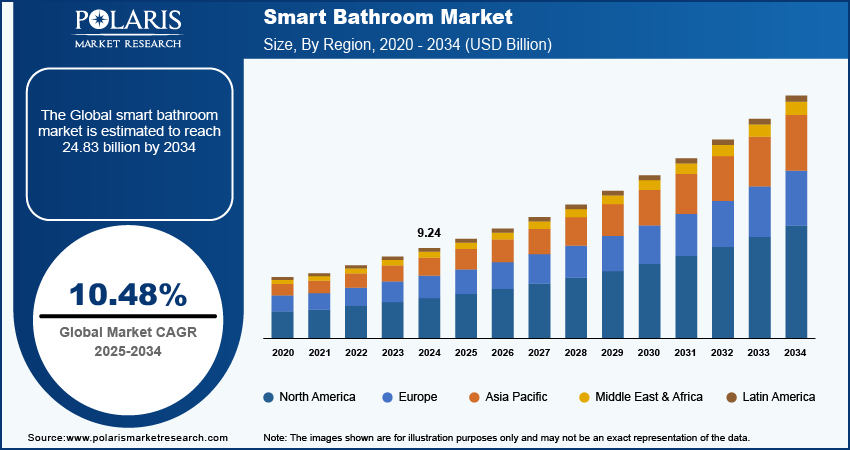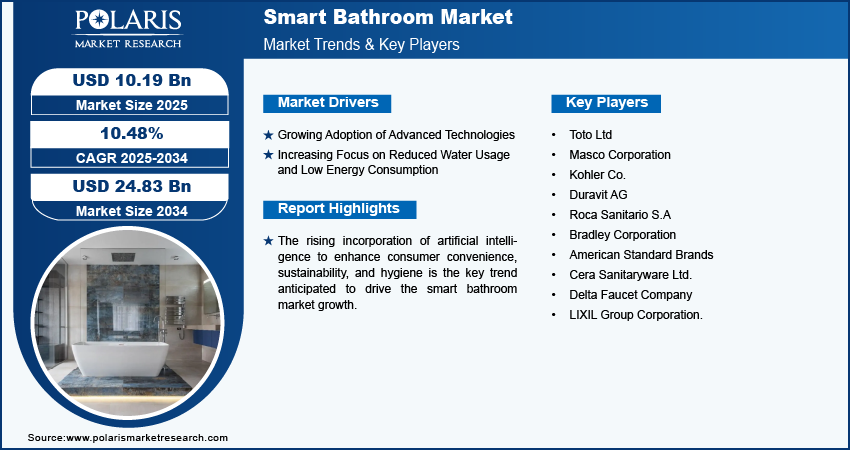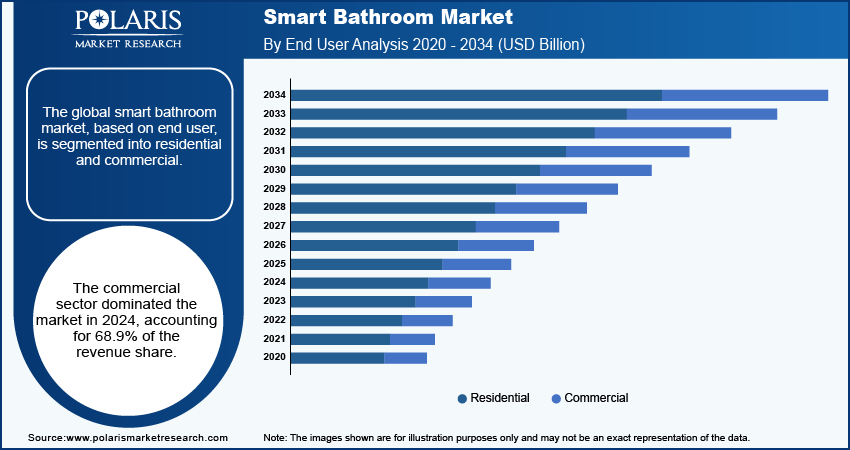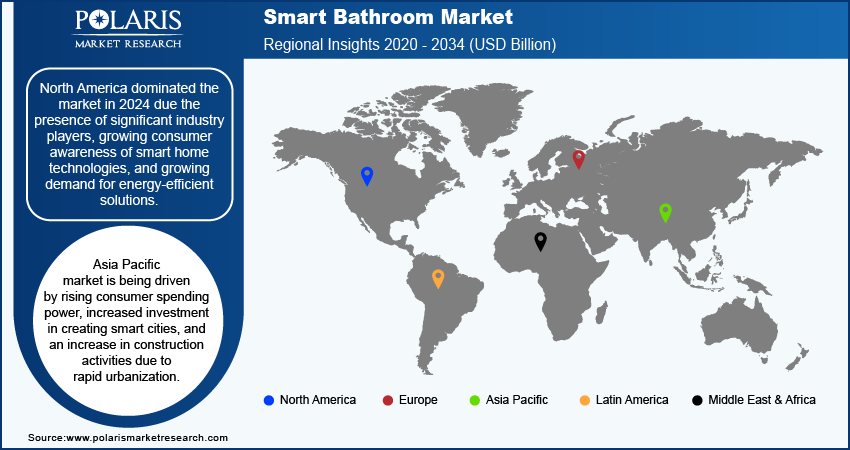
Smart Bathroom Market Size, Share, Trends, Industry Analysis Report: By Product (Smart Toilet, Smart Soap Dispenser, Smart Faucet, Smart Shower, Smart Bathroom Mirror, Smart Bathtub, and Others), Component, End User, and Region (North America, Europe, Asia Pacific, Latin America, and Middle East & Africa) – Market Forecast, 2025–2034
- Published Date:Nov-2024
- Pages: 114
- Format: PDF
- Report ID: PM1569
- Base Year: 2024
- Historical Data: 2020-2023
Smart Bathroom Market Statistics
The global smart bathroom market size was valued at USD 9.24 billion in 2024. The market is anticipated to grow from USD 10.19 billion in 2025 to USD 24.83 billion by 2034, exhibiting a CAGR of 10.48% during 2025–2034.
Smart Bathroom Market Overview
Smart bathrooms include automated plumbing and bathroom fittings to provide seamless control through mobile devices or remotely through wireless communication. It offers centralized control of various functionalities such as lighting, air conditioning and heating, automatic doors, digital faucets, soaking tubs, hot gadgets, and automatic toilets. The growing adoption of smart homes in both developing and developed countries around the world is driving the demand for smart bathrooms. Also, as owners are willing to improve their spaces, there is an increasing demand for a range of smart bathroom solutions across the residential and commercial sectors, which is contributing to the smart bathroom market expansion.

To Understand More About this Research: Request a Free Sample Report
The growing penetration of smartphones and other smart devices and increasing awareness regarding health hygiene are primarily driving the smart bathrooms market growth. Moreover, other factors propelling the market growth are increasing costs associated with energy consumption, rising disposable income of consumers, and improving lifestyles.
Smart Bathroom Market Dynamics
Growing Adoption of Advanced Technologies
Various advanced technologies such as the Internet of Things (IoT), artificial intelligence (AI), and sensing technologies are being integrated into the development of innovative smart bathroom products. A bathroom with multiple smart systems and devices installed offers increased functionality, comfort, energy efficiency, and personalization. Smart bathroom products offer easy remote control for different functions in the bathroom, such as changing water temperature, altering lighting, or turning on/off certain features using voice commands. The smart bathroom market is expanding due to the increased use of touchless technologies in bathrooms, such as motion-sensor faucets, voice-activated controls, and UV sanitation for faucets and toilets. In February 2024, Kohler introduced the Numi 2.0 smart toilet. The smart toilet incorporates several advanced features such as voice commands, dual flush, and integrated flush cleaning to transform user experiences.
Increasing Focus on Reduced Water Usage and Low Energy Consumption
Water scarcity and environmental concerns have made water-saving measures a top priority for both governments and citizens. In order to promote eco-friendly practices and reduce water waste, smart bathroom solutions incorporate technology such as intelligent toilets, smart showers, and automatic faucets that monitor and regulate water usage.
Energy efficiency also has a big impact on the smart bathroom market. The growing emphasis on reducing energy use and electricity costs has led to the inclusion of energy-efficient features in smart bathroom products. These include programmable settings that allow users to customize energy usage to their preferences, motion sensors that only activate lights when they are truly needed, and LED illumination. Thus, the rising focus on reducing water usage and energy consumption drives the smart bathroom market growth.

Smart Bathroom Market Analysis – by Segmental Insights
The smart bathroom market is segmented on the basis of product, component, end user, and region.
Smart Bathroom Market Insights by Product
The global smart bathroom market, based on product, is segmented into smart toilet, smart soap dispenser, smart faucets, smart showers, smart bathroom mirrors, smart bathtubs, and others. The smart toilet segment held the largest market share of 38.9% in 2024. The segment growth is ascribed to the advanced properties of the product, such as self-deodorizing and self-cleaning, which make it an environmentally friendly and favored product in the smart bathroom industry. Due to a number of features, such as hands-free flushing, heated seats, motion-activated seats, and integrated night lights, high-tech or smart toilets are becoming increasingly popular in both residential and commercial settings.
The smart faucets segment is expected to register at a significant CAGR during the forecast period. Smart faucets are rapidly gaining popularity across industries due to the emerging concepts of smart bathrooms. Hands-free faucets have emerged as a result of consumers' growing preference for convenience, particularly in the business sector. Also, the demand for smart faucets is anticipated to increase after the COVID-19 pandemic, particularly in commercial buildings such as malls, hotels, and restaurants.
Smart Bathroom Market Insights by End User
The global smart bathroom market, based on end user, is bifurcated into residential and commercial. The commercial sector dominated the market in 2024, accounting for 71.1% of the revenue share. The growing hotel industry and the rising number of restaurants and eateries across the globe are expected to fuel the demand for smart bathrooms in the upcoming years. The smart bathroom market growth prospects are also being contributed by the rising construction of commercial infrastructure in emerging economies.
The residential segment is expected to expand during the forecast period due to rising urbanization and expenditure on home remodeling. Consumer adoption of smart bathroom fixtures is rising as a result of smart, improved, and aesthetically pleasing product innovations made possible by the IoT and the modern urban lifestyle. High-tech toilets, smart showerheads, and smart mirrors are a few of the smart bathroom products that are in high demand due to the expanding trend of home remodeling.

Smart Bathroom Market Outlook by Regional Analysis
By region, the study provides the smart bathroom market insights into North America, Europe, Asia Pacific, Latin America, and the Middle East & Africa. North America dominated the global market in 2024. The region is dominated by the presence of significant industry players, growing consumer awareness of smart home technologies, and rising demand for energy-efficient solutions. Moreover, as more people are aware of the advantages of smart home technologies, the US smart bathrooms market is expanding. Customers are willing to spend money on these advances to improve energy efficiency, convenience, and hygiene.
Asia Pacific, on the other hand, is anticipated to register at a significant CAGR of 10.9% from 2025 to 2034. The Asia Pacific smart bathroom market is being driven by the rising spending power of consumers, increasing investments in creating smart cities, and rising construction activities due to rapid urbanization.

Smart Bathroom Market – Key Players and Competitive Insights
Vendors in the smart bathroom industry are launching new products to meet the growing customer needs. In addition, the market leaders are acquiring and collaborating with tech companies to enhance their offerings in the market and expand their customer base. The smart bathroom industry is highly competitive with the presence of many small and large vendors. A few leading players in the market are Toto Ltd, Masco Corporation, Kohler Co., Duravit AG, Roca Sanitario S.A, Bradley Corporation, American Standard Brands, Cera Sanitaryware Ltd., Delta Faucet Company, and LIXIL Group Corporation.
List of Key Companies in Smart Bathroom Market
- Toto Ltd
- Masco Corporation
- Kohler Co.
- Duravit AG
- Roca Sanitario S.A
- Bradley Corporation
- American Standard Brands
- Cera Sanitaryware Ltd.
- Delta Faucet Company
- LIXIL Group Corporation.
Smart Bathroom Industry Developments
November 2023: Kohler partnered with Harman Kardon to introduce the KOHLER Moxie showerhead + wireless speaker. According to Kohler, the product features a full-coverage spray and dynamic speakers to bring a new water and audio experience to the showering space.
March 2023: Roca announced the launch of the In-Wash Insignia shower toilet. The new toilet features Roca Connect technology to offer exceptional comfort and hygiene. With its accompanying mobile app, called In-Wash Insignia, users can have the option to customize and regulate several operational modes and functionalities.
January 2023: Kohler introduced the Sprig Shower Infusion System. The new system features the Sprig Shower Pods, which can infuse the water streams with scents such as eucalyptus and lavender. Also, they contain skin-friendly ingredients to offer a luxurious spa-like experience.
Smart Bathroom Market Segmentation
By Product Outlook
- Smart Toilet
- Smart Soap Dispenser
- Smart Faucets
- Smart Showers
- Smart Bathroom Mirrors
- Smart Bathtubs
- Others
By Components Outlook
- Hardware
- Software
- Services
By End User Outlook
- Residential
- Commercial
- Hotels & Restaurants
- Gyms
- Spa & Wellness Centers
- Others
By Region Outlook
- North America
- US
- Canada
- Europe
- Germany
- UK
- France
- Italy
- Spain
- Russia
- Netherlands
- Rest of Europe
- Asia Pacific
- China
- India
- Japan
- Korea
- Thailand
- Malaysia
- Singapore
- Australia
- Philippines
- Indonesia
- Rest of Asia Pacific
- Latin America
- Brazil
- Mexico
- Argentina
- Rest of Latin Ameica
- Middle East and Africa
- Saudi Arabia
- UAE
- Oman
- South Africa
- Rest of Middle East and Africa
Smart Bathroom Market Report Scope
|
Report Attributes |
Details |
|
Market Size Value in 2024 |
USD 9.24 billion |
|
Market Size Value in 2025 |
USD 10.19 billion |
|
Revenue Forecast by 2034 |
USD 24.83 billion |
|
CAGR |
10.48% from 2025 to 2034 |
|
Base Year |
2024 |
|
Historical Data |
2020–2023 |
|
Forecast Period |
2025–2034 |
|
Quantitative Units |
Revenue in USD billion and CAGR from 2025 to 2034 |
|
Report Coverage |
Revenue Forecast, Market Competitive Landscape, Growth Factors, and Trends |
|
Segments Covered |
|
|
Regional Scope |
|
|
Competitive Landscape |
|
|
Report Format |
|
|
Customization |
Report customization as per your requirements with respect to countries, regions, and segmentation. In-depth analysis of annual sales and smart bathroom market forecast in USD billion/million from 2024 to 2032. |
FAQ's
The global smart bathroom market value reached USD 9.24 billion in 2024 and is projected to grow to USD 24.83 billion by 2034.
The global market is projected to register a CAGR of 10.48% during the forecast period.
North America dominated the smart bathroom market share in 2024.
• A few key players in the market are Toto Ltd, Masco Corporation, Kohler Co., Duravit AG, Roca Sanitario S.A, Bradley Corporation, American Standard Brands, Cera Sanitaryware Ltd., Delta Faucet Company, and LIXIL Group Corporation.
